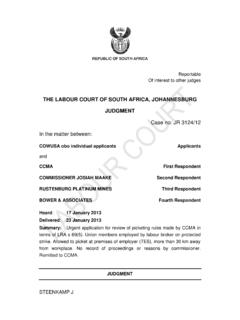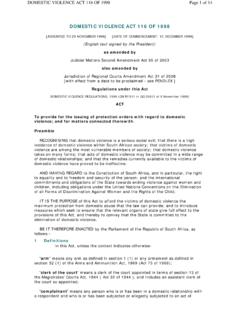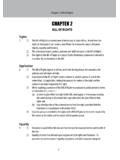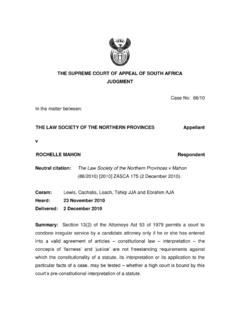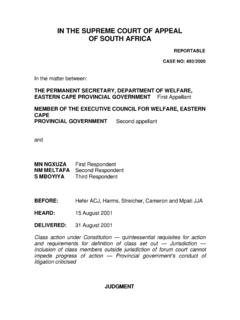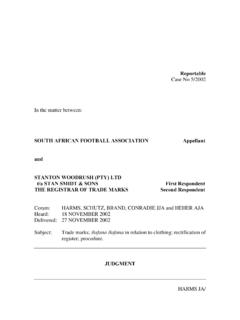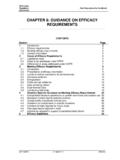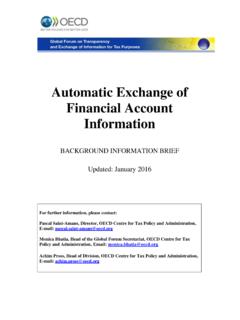Transcription of 2015 The PAJA Mainstreaming Guide A4 - Justice Home
1 1 XLI HSN GHJustice and Constitutional DevelopmentDepartment: REPUBLIC OF SOUTH AFRICA The Promotion of Administrative Justice Act (PAJA) is a law passed by Parliament, to give effect to the constitutional rights to lawful, reasonable and procedurally fair administrative action, as well as the right to written reasons. The Guide offers practical tools on how to mainstream the PAJA into administrative decisions. The PAJA Mainstreaming Guide for Organs of State 2 Putting good governance into practice IFOREWORDIt is a special honour for me to present the PAJA Mainstreaming Guide for organs of Constitutional values, rights and principles enshrined in the Constitution of the Republic South Africa, 1996, permeate every aspect of government.
2 In this instance the right to administrative Justice in section 33 of the Constitution speaks to Parliament, it speaks to Courts, and more importantly to the Executive. The Promotion of Administrative Justice Act, 2000 (Act No. 3 of 2000) (PAJA) was enacted to give effect to the four rights in section 33 of the Constitution, uses the concept of administrator to describe an organ of state or any natural or juristic person taking administrative action, it focuses on the administrative action rather than the decision-maker.
3 Thus administrators have to take the right to administrative Justice into account in their exercise of a public power or performance of a public function. The purpose of this Guide is to assist and Guide them to do so by:t QSPWJEJOH BENJOJTUSBUPST XJUI BTTJTUBODF PO IPX UP TZTUFNBUJDBMMZ JOUFHSBUF UIF 1"+" SFRVJSFNFOUT JOUP administrative decision-making processes; and t DPOUSJCVUJOH UP UIF DSFBUJPO PG BO JOTUJUVUJPOBM FOWJSPONFOU UIBU FOBCMFT PSHBOT PG TUBUF UP JNQMFNFOU UIF 1"+" SFRVJSFNFOUT This Guide is nevertheless only a Guide .
4 It is not intended to be a substitute for section 33 of the Constitution, the PAJA itself or any relevant legislation or executive policy (such as the Ministerial Handbook and the Manual on Executive Acts of the President) or departmental policy that may inform an administrative would like to convey my appreciation to the Deutsche Gesellschaft f r Internationale Zusammenarbeit (GIZ) GmbH, members of the Interdepartmental Working Group (IWG) on the PAJA, the South African Social Security Agency, the various national and provincial departments and three local municipalities who made their valuable inputs to the development of this Guide in various forms.
5 Their contributions are a right step from the text of the Constitution and the law to real life TN SINDANEDIRECTOR-GENERAL: DEPARTMENT OF Justice AND CONSTITUTIONAL DEVELOPMENT II IIITABLE OF CONTENTSC ontents PageFinding your way around the implementation Guide IVList of abbreviations 1 Glossary of Terms 2 CHAPTER 1: Introduction PAJA implementation and the Mainstreaming Guide The purpose of the Mainstreaming Guide How the Mainstreaming Guide was developed 5 CHAPTER 2: Why the PAJA Mainstreaming is Important to you as an Administrator The PAJA in relation to your role as an administrator How does the PAJA affect administrative decision-making?
6 What does Mainstreaming of the PAJA into business processes mean? The PAJA Mainstreaming approach Roles and responsibilities of Key stakeholders in the PAJA Mainstreaming approach Core PAJA Mainstreaming implementation principles 12 CHAPTER 3: The PAJA Mainstreaming Approach:Implementation Guidelines and Tools Guide to understanding the Mainstreaming phases 5 Phases of the PAJA implementation model 15 Phase 1: Establish shared objectives and commitment 15-18 Phase 2: Identify and prioritise administrative decisions 19-22 Phase 3.
7 Analyse administrative decision-making processes for PAJA compliance 23-27 Phase 4: Amend decision-making processes and tools 28-31 Phase 5: Implement and monitor the PAJA Mainstreaming implementation 32-33 List of references 34 IVFINDING YOUR WAY AROUND THE IMPLEMENTATION GUIDEC hapter 1 Purpose of the guideChapter 2 Why the PAJA Mainstreaming is important to you as an administrator?Chapter 3 The PAJA Mainstreaming approachList of referencesA list of references and resources for further 1 LIST OF ABBREVIATIONSA bbreviations DescriptionPAJA The Promotion of Administrative Justice Act, 2000 (Act No.)
8 3 of 2000)DoJ&CD Department of Justice and Constitutional DevelopmentMPAT Monitoring Performance Assessment ToolOPSC Office of the Public Service Commission NGOs Non-Government Organisations/ Non-profit OrganisationsSOPS State of the Public ServicePALAMA Public Administration for Leadership and Management AcademyG&A Governance and Administration ClusterDPSA Department of Public Service and AdministrationLIST OF SYMBOLS AND WHAT THEY MEANM eaning SymbolExampleImplementation ToolsInformation SheetProcess/steps in the mainstreamingImportant considerations 2 GLOSSARY OF TERMS Terms DescriptionAdministrative action Means any decision taken, or any failure to take a decision, by (a) an organ of state, when (i) exercising a power in terms of the Constitution or a provincial constitution; or (ii) exercising a public power or performing a public function in terms of any legislation.
9 Or (b) a natural or juristic person, other than an organ of state, when exercising a public power or performing a public function in terms of an empowering provision, which adversely affects the rights of any person and which has a direct, external legal effect, but does not include, the following; (for example) Executive powers and functions, Legislative powers and functions and Judicial functions. Administrator Means an organ of state or any natural or juristic person taking administrative action.
10 Examples include, ministers, managers and supervisors in organs of state participating in the administrative decision-making process. Business Unit Means a work unit or department within an organ of state. %FDJTJPO .FBOT BOZ EFDJTJPO PG BO BENJOJTUSBUJWF OBUVSF NBEF QSPQPTFE UP CF NBEF PS SFRVJSFE UP CF made, as the case may be, under an empowering provisionEmpowering Provision Means a law, a rule of common law, customary law, or an agreement, instrument or other document in terms of which an administrative action was purportedly takenFair procedure Means that administrators should follow a procedure that will enable consultation, representation and communication of a decision and rights.



